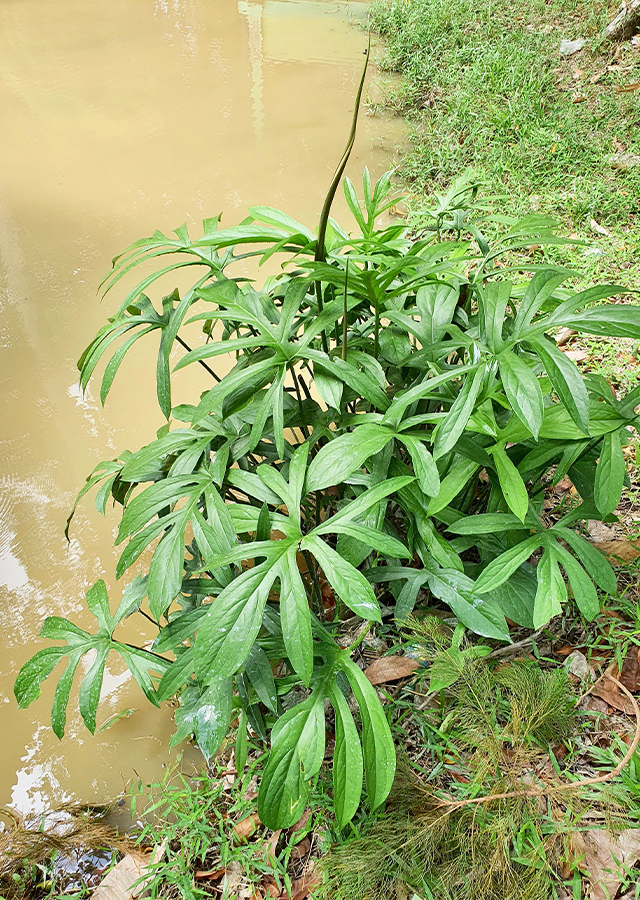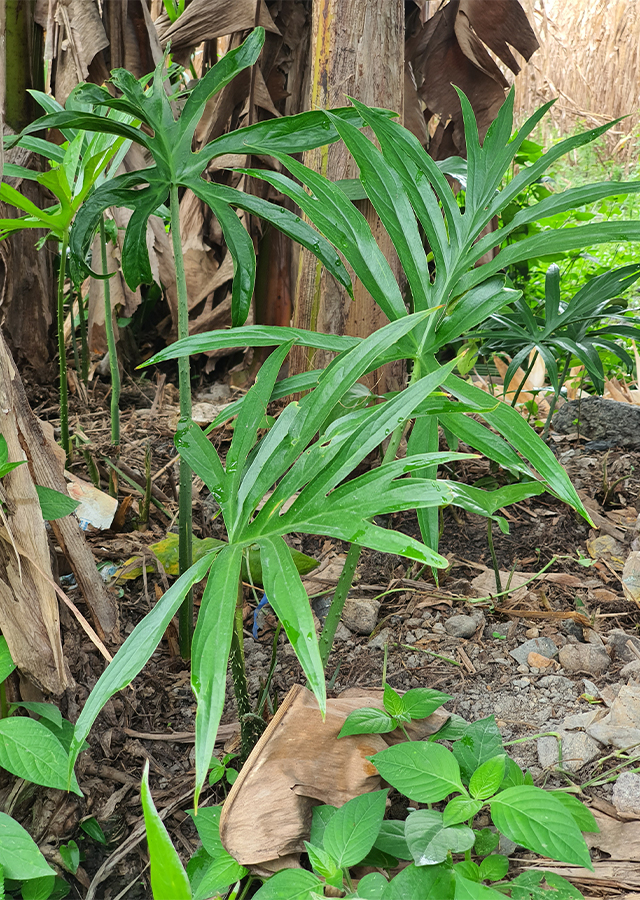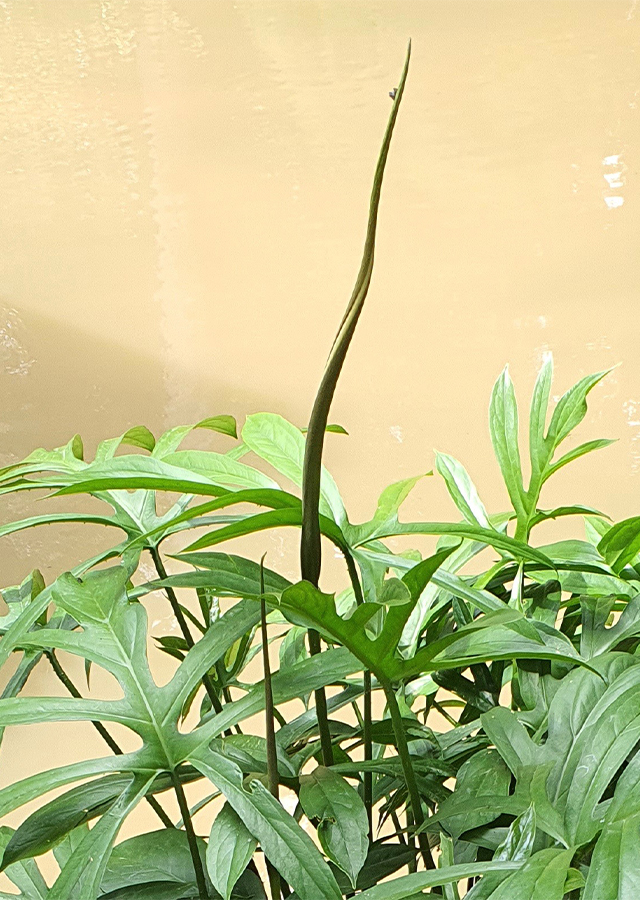Lasia
Lasia spinosa (L.) Thwaites
Araceae
Location in our garden
Aquatic



Synonym
Dracontium spinosum L.
Lasia aculeata Lour.
Lasia crassifolia Engl.
Habitus
Herbaceous. An evergreen, perennial herbaceous plant growing 1 to 2 m tall.
Part Used
Leaves
Stem
Rhizome
Growing Requirements
Full Sunshine
Need Shade
Habitat
Wetland
Riverbanks
Forest
Terrestrial
Overview
Lasia (Lasia spinosa) is native to tropical Asia, from India to New Guinea, including South-East Asia, occasionally cultivated. Plants are typically harvested from natural environments, and often cultivated for family use. It belongs to the Araceae family, where most members contain crystals of calcium oxalate. Calcium oxalate, however, is quickly broken down by either cooking the plant thoroughly or by drying it entirely, and it is healthy to eat the plant in either of these states.
Vernacular Names
Ci yu (Chinese), Laksmana (Sanskrit), Mulasari (Tamil), Pak norm (Laos), Geli-geli (Malaysia), Phak naam (Thai), Rau mớp, Mớp ráy gai (Vietnamese).
Agroecology
Present in the wild in tropical and subtropical areas at low to moderate elevations. It grows in shallow waters and swampy soils, often grown in fish ponds and rice fields. It can grow less than 1,500 m asl and soil pH is 6.1 to 7.8.
Morphology
- Stem - long creeping and stoloniferous, erector ascending, 2.5 cm in diameter, internodes with stout prickles.
- Leaves - rosette, simple, lanceolate, sagittate, or pinnatipartite, thorny along the veins, 30-45 cm long, up to 25 cm wide; petiole 20-50 cm long.
- Spathe - twisted, opening only at the bases, 15 to 30 cm long, brown or purple.
- Spadix - cylindrical, up to 6-8 cm long and 3-3.5 cm wide; peduncle thorny.
- Fruit - berryobovoid, muricate at the top, 1 cm long.
- Seed - 5 mm long, 3.5 mm wide.
Cultivation
Propagation is by dividing the rootball, rhizomes, tubers, corms, or bulbs (including offsets) and through seeds.
Chemical Constituents
Alkaloids, tannins, phenol, flavanoid, steroids, saponins, glycosides, askorbic acid, α-carotene, ß-carotene, ß-carotene-5, 6, 5/, 6/ diepoxide, 5, 6, 5/ 6/-diepoxy-5, 8, 5/,8/-tetrahydro-ß, ßarotene-3,3/ -diol, Cis-neoxanthin.
Traditional Medicinal Uses
- In Bangladesh, the plant is recommended for intestinal disorders, rheumatism, and colic. The corm is used as a therapy for throat disorders.
- In India, the young tender leaves and stalks are used to treat intestinal worms' infections and demonstrate profound anticestodals efficacy. Furthermore, leaves are used for stomach aches and other pains. The rhizome is used for the treatment of lung inflammation, bleeding cough, and the whole plant in the uterine.
- In Sri Lanka, the juice of the rootstock is given as a remedy for piles, hemorrhoids. Black Lasia is used as a treatment for chemical poisoning, hemorrhoids, and pistula.
- In Vietnam, the plant is used as an anti-rheumatic and anti-inflammatory remedy.
- In China, rhizomes are used medicinally for treating tuberculosis of lymph nodes, swollen lymph nodes, stomach, snake and insect bites, injuries, and rheumatism.
Part Used
Reference Sources
- Dave's Garden. (2020). Lasia (Lasia spinosa). Dave's Garden Web. https://davesgarden.com/guides/pf/go/111722/#b (Accessed 13-08-2020)
- Fern, K. (2019). Useful Tropical Plants Database: Lasia spinosa (L.) Thwaites. Useful Tropical Plants Database Web. http://tropical.theferns.info/viewtropical.php?id=Lasia+spinosa (Accessed 13-08-2020)
- Flora of China. (2020). Lasia spinosa (Linnaeus) Thwaites. eFloras.org Web. http://www.efloras.org/florataxon.aspx?flora_id=2&taxon_id=200027287 (Accessed 13-08-2020)
- Plant Resources of South-East Asia (PROSEA). (2016). Lasia Spinosa (PROSEA). Plant Resources of South-East Asia (PROSEA) Web. https://uses.plantnet-project.org/en/Lasia_spinosa_(PROSEA) (Accessed 13-08-2020)
- Ranil, R.H.G., Pushpakumara, D.K.N.G., & Bandaranayake, W.M.T.P., et al. (2020). Lasia spinosa (L.) Thw., A high potential underutilized aroid in Asia: A step toward utilizing neglected crop genetic resources for food and nutritional security. In: Landscaping Agroecosystems: A Way Forward for Natural Resource Utilization, Perera, S.A.C.N., & Mohotti, A.J. (eds.). Colombo: Institute of Biology Sri Lanka. pp. 119-142.


